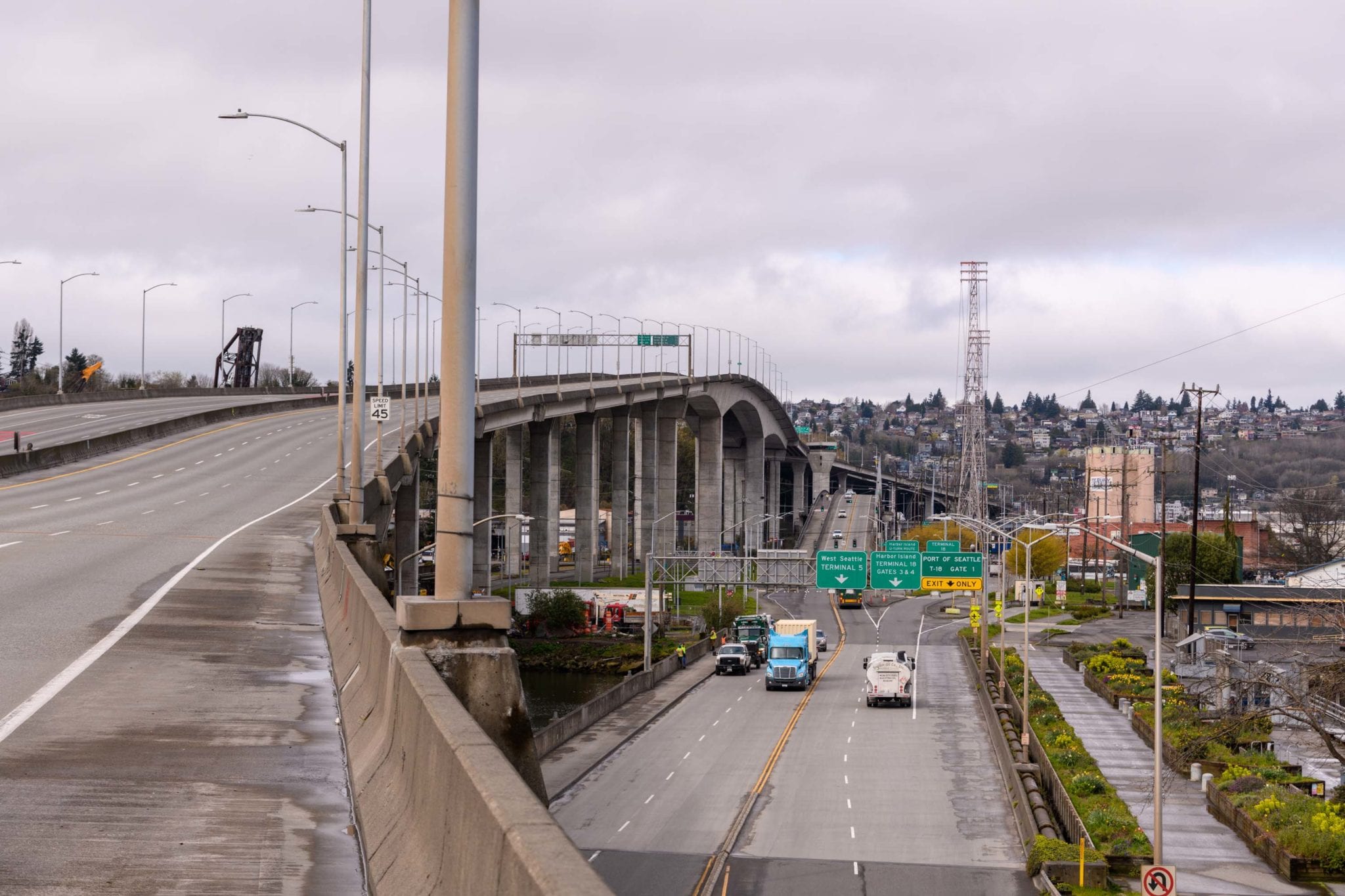
At the West Seattle Bridge Community Task Force meeting yesterday, members agreed with our recommendations that we should immediately expand access to the West Seattle Low Bridge, also known as the Spokane Street Bridge, to all vehicles at night between 9 PM and 5 AM, 7 days a week, as well as anytime access for public and private school buses. SDOT has made effective immediately these two changes to expand the Low Bridge access policy.
A key focus for yesterday’s West Seattle Bridge Community Task Force meeting was to identify potential changes to the Low Bridge access policy that would enable broader use in the immediate and near-term without compromising public safety and unfettered access for emergency vehicles driving on and off the peninsula.
The greatest obstacles to overcome are:
- In order to protect public safety and avoid gridlock traffic in all directions, there just isn’t a lot of Low Bridge capacity to share
- While enforcement is key, a scalable, long-term enforcement solution will take time to implement
- Any policy must be dynamic and subject to change in ways that could both improve or restrict Low Bridge access as new data and patterns emerge
After thoughtful questions and discussion about these obstacles and which categories of users should qualify for future use of the Low Bridge, the Community Task Force came to consensus around the feasibility of immediately opening the Low Bridge at night to all vehicles, from 9:00pm to 5:00am, seven days a week, and expanding Low Bridge access to public and private school buses.
SDOT considered this input and agreed that those two actions can be put in place immediately, without impacting public safety or unfettered access for emergency vehicles. These changes are effective immediately, but subject to change if conditions warrant.
The Community Task Force also provided guidance on additional categories of users – including maritime and industrial workers close to Harbor Island and employer shuttles – with more discussion and data sharing needed before near-term access is granted.
The meeting yesterday also included an update on the status of the High-Rise Bridge and upcoming work to stabilize the bridge, introduction to the Technical Advisory Panel co-chairs and the questions they are currently exploring, and thoughtful feedback on the Reconnect West Seattle and Neighborhood Traffic Mitigation proposals that were introduced at last week’s meeting.
Consistent with our commitment to communication and transparency, this meeting was streamed live for public viewing. If you missed it, we will include a recording of the meeting when it becomes available. In addition, we also wanted to share highlights from the meeting.
A closer look at the data shaping efforts to equitably allow more access to the Low Bridge, while ensuring emergency access.
In any consideration of access to the Low Bridge while the High-Rise Bridge is closed, it is important to always remember three things:
- The Low Bridge, at one lane in each direction, will never be a substitute for the High-Rise Bridge’s seven lanes.
- Any policy for managing increased access to the Low Bridge must be dynamic, as any change in policy, in the community, or elsewhere could result in unanticipated outcomes.
- And above all, public safety is our top priority and is the reason why we restricted use of the West Seattle Low Bridge to emergency vehicles, freight, and transit as soon as the High-Rise Bridge closed on March 23, 2020. We must not forget that we are still in the midst of a public health crisis and must remain central to all Low Bridge policy revisions.
After sharing that context with the Community Task Force, SDOT’s Transportation Operations Division Director Adiam Emery presented our traffic analysis that will shape and inform any increase in Low Bridge access.
What our traffic analysis shows is that the Low Bridge can only handle 400-500 vehicles per hour, total, in each direction, before significant backup occurs, gridlocking drivers and shutting out crucial emergency access. This translates into an ability to permit roughly 160 additional vehicles per hour, in each direction, to use the Low Bridge before exceeding that 400-500 vehicle cap, when public safety is put at risk.
Given that very small number, the Task Force began to discuss what equitable access looks like, how to implement any changes, and when.
One of the limiting factors is the 5-way intersection of Delridge Way SW, Chelan Ave SW, and W Marginal Way SW, just west of the bridge. When westbound traffic levels exceed 500 vehicles an hour, the intersection causes a backup on the Low Bridge that extends to the Spokane Street intersection with the Terminal 5 access ramp.
This spring we made significant improvements to the 5-way intersection, but it is still at risk of backup when traffic levels exceed 500 vehicles per hour.
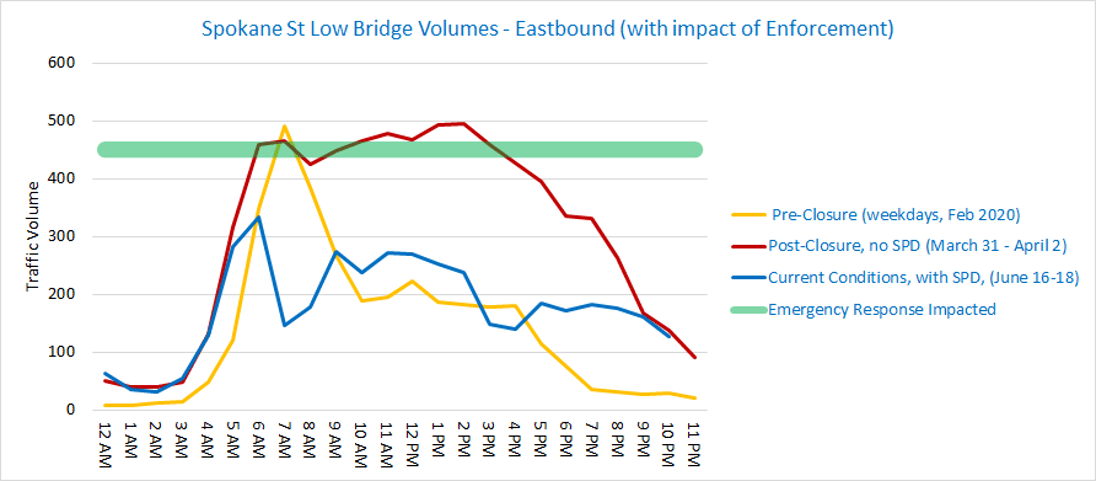
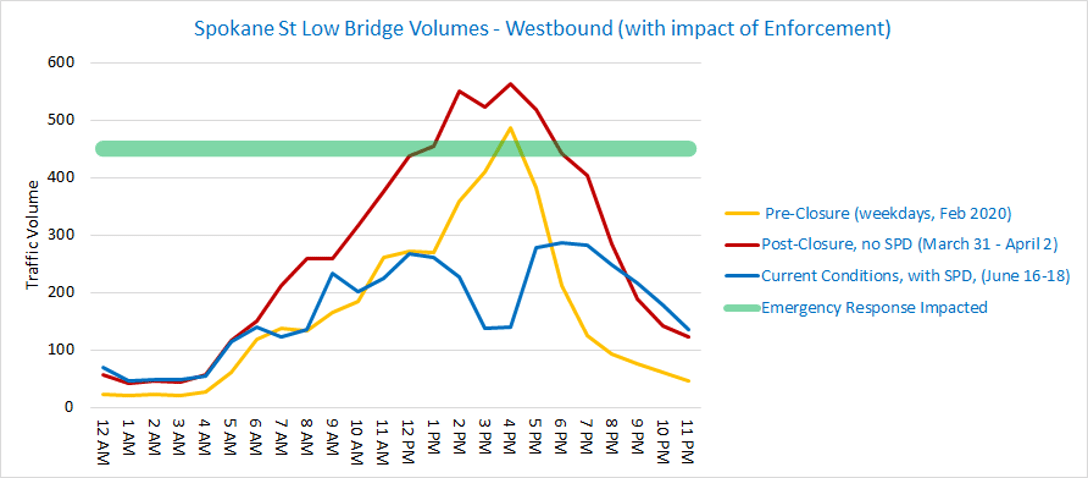
Take a look at the graphs above showing eastbound and westbound hourly weekday traffic volumes across the Low Bridge.
- The yellow lines show what traffic volumes looked like on weekdays back in February 2020. This was before the closure of the West Seattle High-Rise Bridge, and before the COVID-19 “Stay Home Stay Healthy” order was in plac.
Traffic volumes hit the 400-500 threshold during peak travel times but remained steadily around 200 cars per hour outside of peak travel times during the day. Unfettered emergency vehicle access, however, could be serviced by the High-Rise Bridge.
- The red lines show what traffic volume looked like the week of March 31. This was the second week that the High-Rise Bridge was closed, but before the Low Bridge restrictions were enforced. It is important to note that this was during the beginning of the “Stay Home Stay Healthy” order, when traffic volumes were down nearly 60% across the city. Though only two-fifths of normal traffic was on the road, emergency vehicle access was impeded at nearly all moments of the day.
- The blue lines show recent traffic volumes recorded in May with enforcement in place. During this time, the bridge was limited to emergency vehicles, freight, and transit, with Seattle Police officers upholding bridge restrictions during peak travel hours. Traffic across the city was down 53% compared to May 2019.
The dips in traffic volumes during weekday AM and PM peak periods in both directions represent the timeframe when Seattle Police were in place, enforcing the restrictions. This suggests two things. First, that drivers limit their use of the Low Bridge to non-critical levels when enforcement occurs. And second, they change their travel habits to choose either the detour route when enforcement is present, or elect a different time of day to travel across the Low Bridge.
This traffic analysis indicates that there is room to slightly expand bridge access beyond emergency vehicles, freight, and transit during weekdays, but enforcement is imperative and must be consistently present to maintain emergency response access. This led to a discussion about the need to explore automated enforcement as a scalable, safe option.
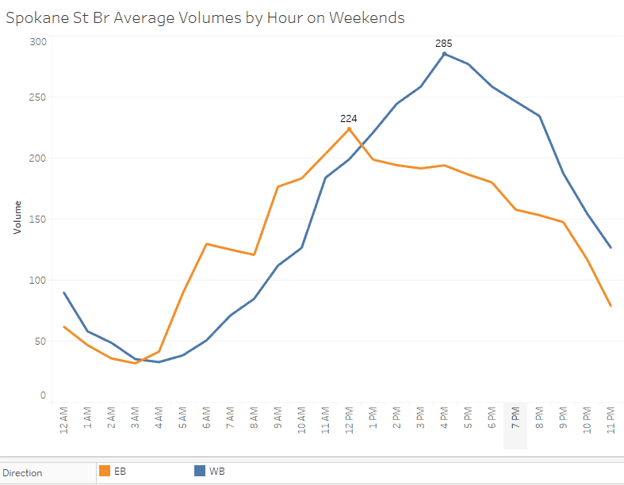
Our analysis of weekend traffic on the Low Bridge indicated that even with traffic down 53%, we are still nearing maximum capacity on weekends. While we will continue to explore increased weekend access, it will likely depend on the implementation of scalable enforcement solutions.
Additionally, in all cases of weekday and weekend travel, traffic volumes at night between 9 PM and 5 AM remained low, indicating that the allowance of universal use during this time would not impact public safety.
SDOT is exploring the use of automated enforcement of Low Bridge restrictions and if feasible, could serve as a key milestone for equitably increasing access
During today’s Task Force discussion, it became clear that most policy proposals to increase Low Bridge access in a way that is equitable and does not detrimentally impact public safety depends on the ability to enforce them.
A permanent SPD presence is not a preferred, scalable, or affordable approach and, thus, SDOT has begun to explore the potential use of automated enforcement mechanisms. This could mean that cameras are added to an existing contract managed by SPD, similar to red light enforcement cameras and school zone cameras.
The use of automated enforcement for Low Bridge access policies would have to be approved by City Council. If it were, SDOT anticipates this technology could be in place later this summer or early fall.
We look forward to sharing more about this potential solution in the coming weeks.
We brought this information to the Community Task Force today to help develop a dynamic, data-driven policy that thoughtfully and equitably allocates access to the bridge.
As mentioned above, today we presented several recommendations for them to consider and evaluate.
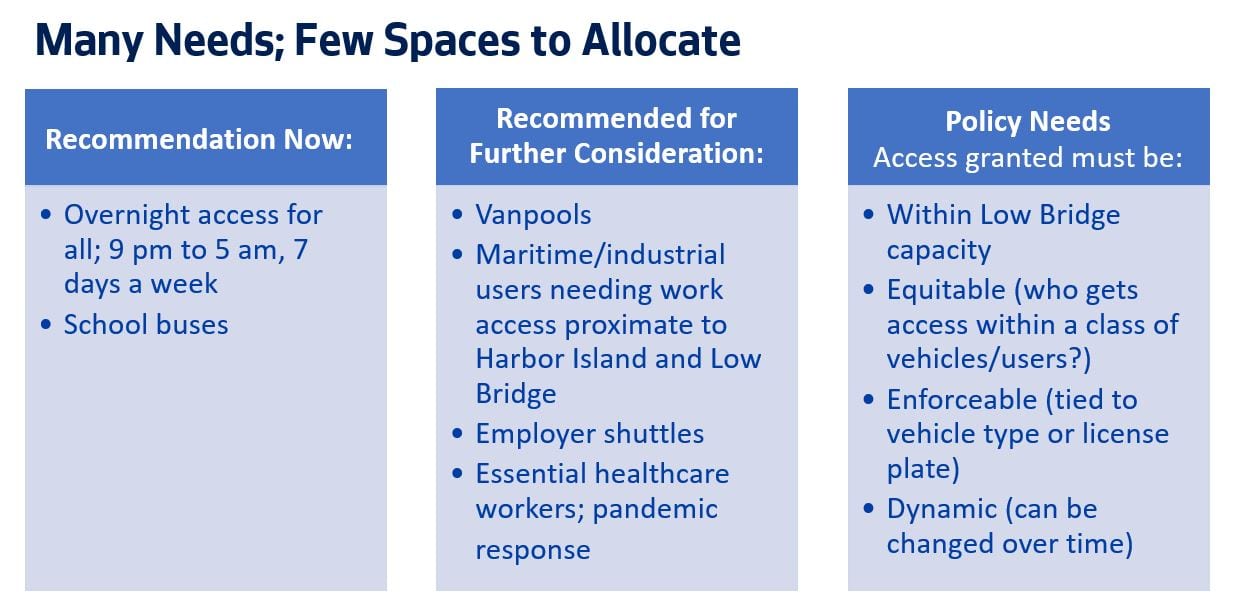
The Community Task Force agreed that we should act immediately to expand access to all vehicles at night between 9:00pm and 5:00am, seven days a week since night time travel was universally low and would not impact emergency access. Additionally, they suggested expanding anytime access for public and private school buses.
At this time, there are further considerations we need to work through before expanding access to vanpools, maritime and industrial users, employer shuttles or essential healthcare workers and pandemic response. A primary limiting factor is not yet having a scalable enforcement system in place. The Community Task Force expressed urgency in expanding access and provided thoughtful feedback on how to proceed.
As we move forward with the recommendations to open nighttime access to all vehicles and anytime access to school buses, we are grateful for the Community Task Force’s questions and guidance. It is important that this remains a dynamic policy as we watch and monitor traffic levels closely.